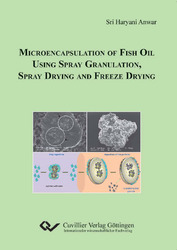| Areas | |
|---|---|
| Serie de libros (96) |
1378
|
| Nachhaltigkeit |
3
|
| Gesundheitswesen |
1
|
| Letra |
2364
|
| Ciencias Naturales |
5406
|
| Matemática | 229 |
| Informática | 319 |
| Física | 980 |
| Química | 1363 |
| Geociencias | 131 |
| Medicina humana | 243 |
| Estomatología | 10 |
| Veterinaria | 108 |
| Farmacia | 147 |
| Biología | 835 |
| Bioquímica, biología molecular, tecnología genética | 121 |
| Biofísica | 25 |
| Nutrición | 45 |
| Agricultura | 1004 |
| Silvicultura | 201 |
| Horticultura | 20 |
| Ecología y conservación de la tierra | 148 |
| Ciencias Ingeniería |
1793
|
| General |
98
|
|
Leitlinien Unfallchirurgie
5. Auflage bestellen |
|
Erweiterte Suche
Microencapsulation of Fish Oil Using Spray Granulation, Spray Drying and Freeze Drying (Tienda española)
Sri Haryani Anwar (Autor)Previo
Indice, Datei (37 KB)
Lectura de prueba, Datei (54 KB)
The stability of microencapsulated fish oil prepared using various drying methods is
investigated. In the preliminary study, two production processes, i.e., spray granulation
(SG) and SG followed by film coating (SG-FC) are examined and compared. First, three
types of fish oil (10/50, 33/22, and 18/12) based on the ratios of eicosapentaenoic acid
(EPA) and docosahexaenoic acid (DHA) are used in the SG process. Each type of fish oil
was emulsified with soybean soluble polysaccharide (SSPS) and maltodextrin to produce
25% oil powders. Second, a 15% film coating of hydroxypropyl betacyclodextrin
(HPBCD) is applied to the SG granules. The powder stability against oxidation is
examined by measurement of peroxide values (PV) and GC-headspace propanal after 6-
week’s storage at room temperature (± 21 ºC) and at 3 – 4 ºC. The results show that the
coated powders have lower stability than uncoated powders and this indicates that the
film coating by HPBCD ineffectively protected the fish oil as the coating process might
have induced further oxidation.
In the main research, emulsions of 33/22 fish oil are prepared with four combinations of
matrices and microcapsules are produced by SG, spray drying (SD), and freeze drying
(FD). The objective is to identify the most critical factors which determine powder
stability and to further examine the superiority of the SG process compared to other
drying processes. Oxidation parameters and analytical methods remain the same as in the
preliminary study, but the storage time is extended to 8 weeks.
The best matrices are a combination of 10% (w/w) SSPS and 65% (w/w) OSA-starch.
Microencapsulation of 620 mg/g fish oil with these coating materials then dried by SG is
able to produce fish oil powder having a very low propanal content and with a shelf life
of five weeks at ± 21 ºC. The ability of SSPS to form thick membranes at the oil/water
interface and the role of both matrices to stabilize emulsion by steric repulsion are
critical to prevent early formation of peroxides. The results of the present research
indicate that instead of layering a single concentrated core, microcapsule formation by
the SG process is actually started by agglomeration of seed particles. The seed particles
are then covered by the growth of droplet deposition and the granule surface is coated by
fine particles. This assumption is supported by scanning electron microscope (SEM)
examinations which verify the raspberry-like microstructure of the final granules.
Therefore, it can be assumed that the SG process produces “multiple encapsulations”
granules and provides maximum protection to the oil droplets.
Comparison of the SG, SG-FC, SD, and FD processes confirms that combination of
matrices, drying temperature, microcapsule morphology, and processing time are among
the most critical factors governing the stability. Exposure to high drying temperature or
heat is proved to be a limiting factor for drying unstable emulsion. If a process does not
apply high drying temperature, the particle morphology becomes a determining factor for
product stability.
The main contribution of this study is to provide in-depth evaluation of four different
drying processes with comprehensive information on the drying mechanisms in relation
to how they affect the stability of microcapsules. The amount of polyunsaturated fatty
acids (PUFAs), fish oil quality, type of matrix, and their physicochemical characteristics
are also discussed in this study.
| ISBN-10 (Impresion) | 3869557176 |
| ISBN-13 (Impresion) | 9783869557175 |
| ISBN-13 (E-Book) | 9783736937178 |
| Formato | A5 |
| Idioma | Inglés |
| Numero de paginas | 210 |
| Laminacion de la cubierta | Brillante |
| Edicion | 1 Aufl. |
| Volumen | 0 |
| Lugar de publicacion | Göttingen |
| Lugar de la disertacion | Bonn |
| Fecha de publicacion | 12.04.2011 |
| Clasificacion simple | Tesis doctoral |
| Area |
Agricultura
|








